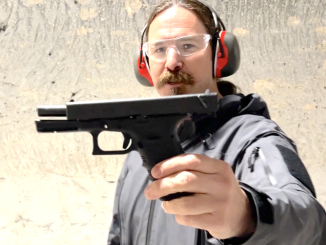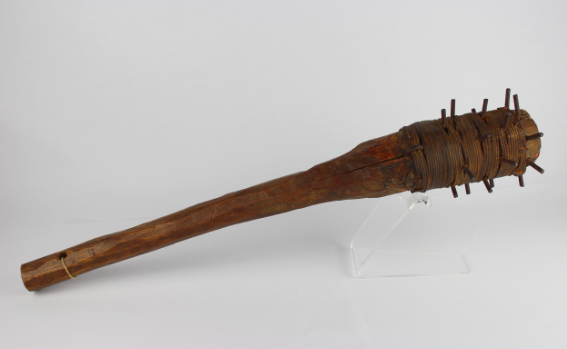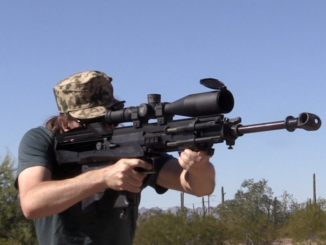This rifle, as best I can tell, is a prototype model made by Steyr in Switzerland in the early 1930s for use in Hungarian military trials. The Hungarians were looking to replace their old 1895 straight-pull Mannlicher rifles with something more modern. They wanted to keep their Mannlicher en bloc clips and ammunition, though – note the same distinctive magazine on this rifle and the M95.
The action that Steyr used for this trials rifle came from an effort to produce an improved German rifle during World War One. The Gewehr 98 had a number of serious deficiencies in trench combat, and Mauser developed an improved model in 1917. It was intended to enter production in 1918, but the collapse of the German armies prevented that from happening. The 98/17 had a flat tangent leaf rear sight, a sliding dust cover, and detachable box magazines, as well as being shorter than the G98. While it was never made in Germany, it did form the basis for the Type 13 Mauser that was manufactured in Manchuria with Steyr’s assistance. So when the Hungarians put out a request for rifle models, Steyr dusted off this action, fitted a Mannlicher type of magazine, and submitted it (note that the dust cover is missing from this rifle, although its mounting grooves are still there).
Ultimately, this did not win the competition, and Hungary chose a Mannlicher action rifle as the 35M instead.




Wish I could afford it. I love Mannlichers so much.
Bolt covers would have made sense given how muddy the Eastern Front was during spring and autumn! The problem is fitting the bolt cover so that it won’t rattle while the bolt is in battery. It has to be finished by hand if I remember correctly. Bottom line is that one should not fall into a swamp or trench rifle first…
Hello Ian,
Have you ever visited the World War 2 after WW 2 blog. They recently had a great article on some the of Mukden Arsenal’s products to include the legendary Liao-13 rifle. In his article, the author mentions the Böhler Corporation as having a part in transferring the tools and KuK M-1917 expertise to Mukden. I thought you might find this interesting.
Thank you for sharing this wonderful rifle with us.
https://wwiiafterwwii.wordpress.com/2017/04/03/mukden-arsenal-after-wwii/
Steyr? Switzerland? hmmmmmm….. 😉
Where is coming from connection between Steyr and Solothurn? Was it result of limitations imposed on Austria as a result of WWI?
Exactly. Under the Versailles Treaty, the Austrian arms industry was under the same restrictions as the German one. So they made the same “under the table” deals with the Swiss and etc. that the German arms makers did.
Steyr sent most of their design staff to Solothurn, because there they could work on whatever the company’s board wanted them to, away from the prying eyes of Allied arms control monitors. And if they came up with something salable in foreign markets, Solothurn handled the marketing, with Steyr getting the cash for the most part.
The manufacturing tended to be done by Steyr, with parts shipped to Solothurn for final assembly and “trademarking”. Hence the various military weapons such as LMGs known to collectors as “Steyr-Solothurn” products today. A lot of them carried only the Solothurn trademark when delivered to the buyers.
After the second war, Walther in West Germany and Manufacture d’Armes de Haut-Rhin (Manhurin) in France had a similar arrangement.
One odd side-effect of this was that the Four Power Agreement concerning West Berlin prohibited the West Berlin PD from having German-made weapons, at the insistence of the Soviets. So for many years, the WBPD were armed with Walther pistols and even MPK and MPL SMGs marked “Manhurin”, to get around that restriction.
cheers
eon
Shortcuts again! If there’s a loophole, expect someone to exploit it!
Very similar “kick” took pace after WWII when Austria resurrected military needed GPMG and could not directly buy (or mimic) German G42. So they went to Beretta and bought a licence to build their own version of MG3 which Beretta produced as war booty.
Loooots of politics in play there.
Well, let’s remember that the Italians got off slightly better after having “switched allegiances” in 1943. Beretta was permitted to keep running because everyone wanted its wonderful toys…
Yeah, right… and it paid for them, much like in previous war. Born weasels 🙂
But on the other hand some of their industries were wrecked and countryside rolled over before ‘switching sides’ by U.S. bombing. They had their own share of suffering, and following identity crisis.
This was possible, if we consider that MP-34 (o) was designed by and intended for Austrian police but manufactured by Swiss factories. Pardon my lack of accent marks. And much of the manufacturing capacity went to Hungary and Czechoslovakia. I could also see a possible typo on Ian’s part. The problem with contracting gun production to Swiss firms is that the price is quite high for a finished product! They definitely prefer to make nearly indestructible weapons, which really raises the minimum price on any given gun…
There is a good article on this connection. Solothurn was originally a cover of the German Rheinische Metall waaren Fabrik, Steyr sold its gun production to Solothurn in 1929. You can find the link here:
http://www.smallarmsreview.com/display.article.cfm?idarticles=1973
So here is an Austro-Hungarian Mauser-Mannlicher rifle. I never had a clue someone combined Mauser action with Mannlicher magazine. It make sense it was
As I tried to write, it make sense it was made by Steyr in Austria for Hungary
Yes it does. This actually would have been direct replacement for Steyr M95 had Austria not lost the war. Mind you, during WWII Steyr built K98 for German Wehrmacht, among other things.
Ian, you are incorrect. During WWI Steyr developed the M.15 rifle which was a Mannlicher-Schönauer rifle in 8×57 caliber (German cartridge). It was not adopted because during war noone would introduce a new caliber.
Two years later followed the M.17 rifle. This was a Mannlicher action but with a Mauser bolt in 8x50R caliber. It was already too late for official introduction.
In the inter-war period the Austrian Army bought 300 rifles with the M.17/30 action. This was basically a M.17 action, but in the 8x56R caliber. It was not adopted by the Austrian Army and therefore offered also to other customers. This particular rifle here is the M.17/30, but made for the export (as a sales sample) which is obvious by the Steyr-Solothurn connection.
Another variant was the M.31 and M.31A, which was a full Mauser action and found introduction with Colombia. This last model is also the ancestor to the later German Luftwaffen-Karabiner.
So this rifle clearly is an M.17/30 sales sample and had was not made in particular for the Hungarian trials.
Good points, so how does one find production rifles? I can’t seem to find pictures of them anywhere…
There is no existing M.15 rifle, aside of drawings. With the M.17 rifles there are two of them in the Austrian Army Museum in Vienna. Of the M.17/30 Austrian Army trials rifles there are two survivors known, one in a private collection in Vienna, the second one in a private museum in Lower Austria (Militärmuseum Sonntagberg). Second rifle has been converted to a Grenade Launcher rifle. Both of the last two rifles are shown in the German gun magazine “RWM Depesche” edition #11.
There are also photos in DWJ 12/2004
Servus,
for which cartridge is this gun – 8 x 56 R?
This gun was made in Austria! Steyr-Solothurn in Steyr.
Heinz
I’ve found some photos of a Mauser 1918 that have been on a forum since 2010.
http://forums.nitroexpress.com/showflat.php?Cat=0&Number=149633&an=0&page=6
It isn’t what I was expecting, particularly with respect to the dust cover and the receiver bridge that is the same diameter as the receiver ring, and hollowed out to allow the dust cover to pass through. Even the reversion to using the root of the bolt handle as a safew years lug.
I’ve actually got more new unanswered questions after seeing the photos than I had before I saw them, particularly regarding control of leaking gas and attachment of the dust cover and the bolt cap.
From memory, I’m reminded of Krag and Jorgensen’s second patent, with its integral dust cover, dual front locking lugs and collar attachment for the bolt sleeve (taken from the K&J designs predecessor, the Jarman).
I’ll see if I can find some Patents.
There we go
https://worldwide.espacenet.com/publicationDetails/biblio?DB=EPODOC&II=0&ND=3&adjacent=true&locale=en_EP&FT=D&date=19220418&CC=US&NR=1413109A&KC=A
It looks like the rear bolt cap is held by screw threads in the patent, compared to the much neater lugs used in the Steyr and the Steyr inspired Manchurian Mukden arsenal guns https://www.forgottenweapons.com/type-13-manchurian-mauser-a-ww1-legacy-in-china/ .
It’s looking like the Steyr and Steyr inspired Mukden guns are taking a seperate development path to the actual 1918 Mauser gun.
Krag & Jorgensen’s two lug action for comparison of the dust cover with the 1918 Mauser. https://worldwide.espacenet.com/publicationDetails/originalDocument?CC=US&NR=492212A&KC=A&FT=D&ND=3&date=18930221&DB=EPODOC&locale=en_EP
Re watching this and the Manchurian type 13 videos…
The Mauser 98 longitudinal guide rib on the bolt (that lies under the extractor spring when the bolt is closed and runs in a slot in the top of the receiver bridge when the bolt is being cycled) has disappeared.
There’s a loss in the stability and smoothness over the bolt
But there’s also a huge savings in machining, as much of the bolt can now be turned on a lathe and cylindrically ground, rather than requiring several expensive formed milling cutters and grinding wheels and several extra machining fixtures set ups and operations.
I’ve seen it claimed that there are more machining operations in the bolt body of a Mauser 98 than there go into an entire Remington 700 rifle
I’ve never counted them up, but it does seem possible. I know which rifle I would prefer to have!